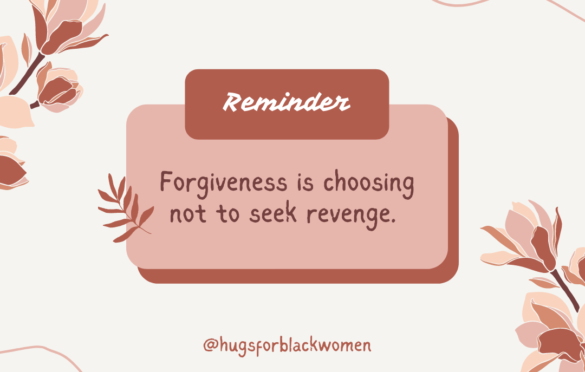The Art of Letting Go

We’ve all been there – betrayed by a confidant, jilted by a lover, mistreated, violated, or disrespected. Feelings of anger can quickly seep in, and if left unaddressed, those feelings can mature into bitterness. One of the few guarantees in life is that we will – at some point – experience suffering. Sometimes, because of our own poor decisions. And other times, at the hands of someone near to us.
No matter the cause, the pain is the same. Guilt, shame, disappointment, anger, and sadness are just a few of the emotions we may feel in the aftermath of heartache. No wonder humans find it hard to forgive. As Ilene Strauss Cohen, Ph.D., puts it, “As human beings, we’re programmed to avoid danger or anyone who has proven to be untrustworthy.” Some call it trusting your intuition, while others believe it’s just plain common sense.
When we’ve experienced hurt at the hands of another, it can be hard to acknowledge, process, and release. Constant thoughts of how we could have avoided the situation or even altered its outcome may plague us to the point of depression. If we arrive at this place – consumed by negativity and continually ruminating on how we were done wrong – it may be time to let it go. Forgiveness is ultimately for us. It helps us heal, evolve, and hope for the best again in life. Learning to forgive can restore what was lost to us and assist us in receiving so much more.
…
Why Forgiveness can be Hard
There’s a slew of reasons forgiving someone who hurt you can prove challenging. Our instinct is to want revenge for the pain we’ve experienced. Many times, we are blindsided or confused by the offense, and we’re fearful that history may repeat itself. Those feelings can take time to heal, and for this reason, we should never attempt to forgive someone before we are truly ready. Forcing ourselves to forgive before then can heighten our feelings of anger and pain. But when we have allowed ourselves time to process the emotional trauma, we can gift ourselves the freedom of forgiveness.
It Helps to Remember
Reframing forgiveness in our minds can help to make all the difference. It doesn’t mean that we’re excusing the behavior or won’t feel the pain anymore. It also doesn’t mean we have to communicate with the offender. Forgiving others is actually for us. It allows us to move forward and reclaim our power. It helps us to feel unburdened and at peace.
How to Forgive
There are so many great articles on how to forgive someone. And they all begin with acknowledging our pain. Being honest with ourselves about what we feel can help to jumpstart the process of letting go. Accepting what we feel and being vulnerable within ourselves can help remove emphasis from the offense. Are our feelings magnified because of previous trauma? Is this a repeated pattern with a specific person? These are all questions we can explore in identifying what we feel.
When we’ve identified our emotions, we can decide what we want. Whether it’s to restore the relationship or let go of negativity, it’s imperative to keep our end goal in mind. Ridding ourselves of ill feelings doesn’t require us to rekindle a connection with our offender. But if we desire to once again experience closeness with those who hurt us, our next step may be to see things from their perspective.
Though not every action warrants empathy, there are instances where a little understanding can go a long way. As humans, we will make mistakes. We are all flawed beings, and no matter how hard we try, we are bound to get it wrong sometimes. Knowing this, we can ask ourselves if the person who hurt us meant to be malicious? Did they purposefully try to harm us, or were they acting out of their own insecurities and limiting beliefs? Considering the other person can help us see them as imperfect human beings, just like us.
…
When we have processed our feelings, we are ready to release them – whatever that may look like for us. Forgiveness is not a one-size-fits-all task. It doesn’t mean we won’t think about the pain anymore. And it doesn’t have to be accompanied by instant reconciliation. It can be a slow process of releasing anger and reminding ourselves that another person’s misdeeds do not define us.
Some activities that can help us include writing a letter to our transgressor. We can begin by explaining how the wrongdoing impacted us and close with a statement of forgiveness. It’s not necessary to send the letter – unless you decide to. The act of writing a letter is to help us find inner peace and gain clarity on how to move forward.
It may also assist us to set boundaries with the person who hurt us. These safeguards can empower us to know who we are and what we will accept. They can also protect us from engaging in the same sort of dynamic that birthed strife between our offender and us previously. Boundaries help us to care for ourselves and respect others simultaneously.
Finally, we must give ourselves grace. Understanding that forgiveness is a process can help manage our expectations when letting go. Forgiveness doesn’t have to happen overnight. We may have to restart the process many times before achieving our goal, and that’s ok. What matters most is that we don’t give up on forgiving others because we too may need to be forgiven one day.





Dominique Kelly
Looking into whether a person intended on being malicious is something I need to consider more often possibly. But I love the peace of removing toxic energy from my life and finding that inner peace again.
Dominique Kelly
Looking into whether a person intended on being malicious is something I need to consider more often possibly. But I love the peace of removing toxic energy from my life and finding that inner peace again.